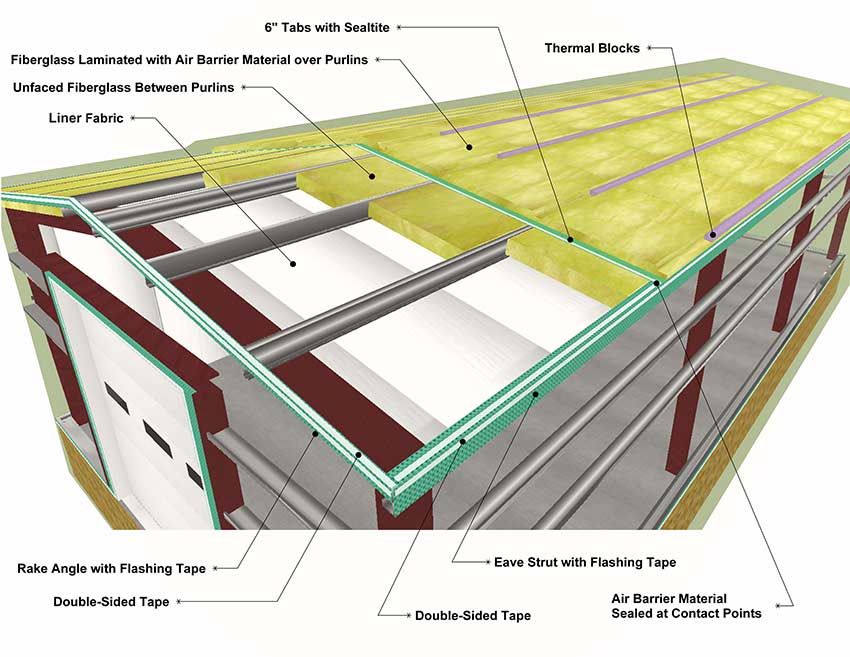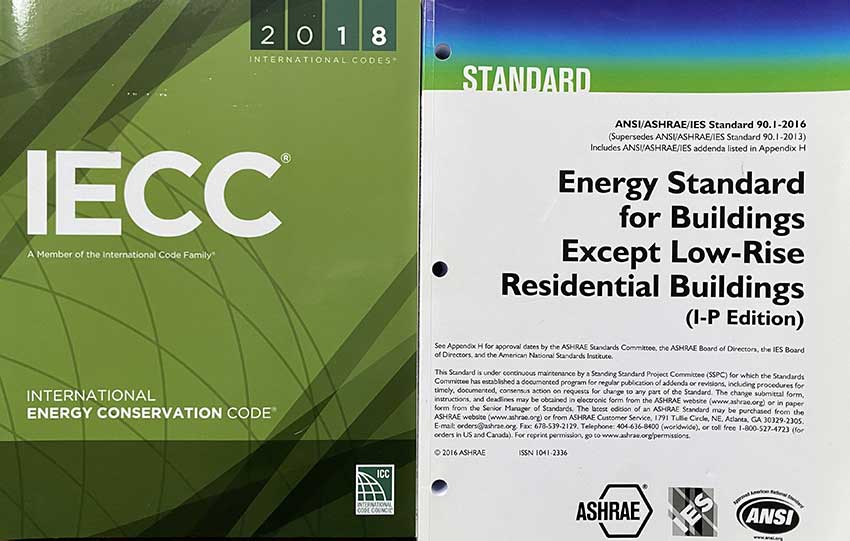Evaluating Metal Building Systems Using COMcheck™
Other assemblies like continuous insulation or proprietary systems may also be used. Air and vapor control can typically be addressed easily with tapes and sealants between facings or liners. In several cases, the exposed insulation facing or liner can create a finished ceiling. Alternatively, a conventional system can be suspended down into the space below. As with walls, insulated metal panels are an option, but they do not qualify as continuous insulation.

Photo courtesy of Therm-All and the Metal Building Manufacturers Association
The insulation approach of a metal building system can include single or double layers of insulation with full air sealing and vapor retarder protections.
Typical Foundation Systems
Metal building system manufacturers don’t provide foundations. Rather they provide an anchor rod plan and the structural engineering reactions for an architect or engineer to design the foundation to be built on-site accordingly. For most low-rise buildings, that usually means a concrete slab on grade, but any type of conventional foundation and first-floor system can be used to support a metal building system. The insulation of the foundation will need to be detailed as with any building and the installation will need to be inspected and verified before the metal building system is assembled and constructed.
THE ENERGY CODE AND COMPLIANCE
The International Energy Conservation Code (IECC) is part of the family of codes that are created, managed, and regularly updated by the International Code Council. It does not exist to regulate energy consumption (i.e., there are no violation orders issued if a monthly utility bill is too high), but to regulate the design and construction of buildings so that energy usage in buildings is better controlled. That control falls into two categories: 1) energy conservation, which is the act of reducing the amount of energy needed in the first place, particularly by addressing the building envelope (insulation, air sealing, glazing traits, etc.); 2) energy efficiency, which means reducing the amount of energy required to power mechanical and electrical equipment such as heating, cooling, lighting, etc. and still achieve the desired outcomes (thermal comfort, proper light levels, etc.). Taken together, we refer to the energy performance of a building as a combination of conservation and efficiency measures that achieve a measurable outcome.
The IECC addresses all of these aspects of energy performance. It also recognizes that eight different climate zones exist around the country that directly impact the energy performance in buildings. Therefore, the provisions are broken down by particular building construction components (building envelope, mechanical systems, etc.) but the specific requirement to show code compliance can vary depending on the climate zone where the building is located. The commercial buildings part of the IECC also recognizes different standard construction systems and assemblies, including recognition of metal building systems as a conventional building type. Therefore, when addressing a provision of the IECC in design, it is necessary to look specifically at the requirements for the climate zone and for the relevant construction systems used in the building.

Photo courtesy of Therm-All and the Metal Building Manufacturers Association
The insulation for roofs in metal building systems can be achieved effectively in a similar manner to walls with options for the amount and type of insulation used.
Compliance Path Option
The IECC, like all codes, sets the minimum standard for performance but does not endeavor to design the building – that is the purview of the licensed design professionals. In that light, the code recognizes that there is more than one way to achieve the required energy performance results depending on the overall design of the building. Therefore, it is possible to show compliance with the IECC in any one of three ways:
- Prescriptive Requirement Path This is the most direct and straightforward means of compliance, although it may or may not be the preferred way to design a building. Showing compliance with the IECC by prescription means that all defined components (wall assemblies, roof assemblies, openings, etc.) are designed and installed as prescribed in the IECC. Tables in the code simply state the minimum R-values or maximum U-factors for different building components that must be met as prescribed, based on the type of component and the climate zone. In this case, the construction assemblies are presumed to be standard, including those for metal building systems. Since the general construction system is presumed to be standard, note that the R-values in the tables refer only to the insulation (not the entire assembly) at the minimum performance level that must be installed, including some requirements for continuous insulation in certain climate zones. There is an alternative to use prescriptive tables based on U-Factors for entire wall and roof assemblies in which case it is incumbent on the designer to demonstrate and prove how the proposed assembly achieves those prescribed U-factors. Therefore, if the wall, roof, and other assemblies are very standard, this prescriptive path may be fairly easy to work with, but many building professionals find it rather restrictive and potentially more difficult to design and construct, particularly where continuous insulation is concerned.
- Building Envelope Trade-off Path In this second means of showing compliance with the IECC, there is an allowance for looking at the overall performance of the combined energy conservation measures including building envelope insulation levels and glazing/opening performance. Essentially, that means some trade-offs are possible where one area of the building can readily exceed the prescriptive minimum (i.e., in the roof assembly) and make up for another area that may fall short (i.e., in the wall assembly or glazing). (See section C101.5.1 of the IECC) Note that this trade-off is limited to the building envelope thermal performance only and does not apply to prescriptive air infiltration requirements or efficiency measures for mechanical and electrical equipment, all of which must still be met.
- Performance Path In some cases, a building designer wants to take all of the conservation and efficiency measures into account and look at the total performance. The IECC allows for this if a full, computerized energy model of the total building performance is prepared and presented according to the stated requirements of the code. In this case, a computerized baseline model must be created as if the building met all of the prescriptive requirements. Then a second computer model is prepared adjusting only those things that are different from the prescribed minimum for the envelope energy conservation and the electrical and mechanical efficiency as designed. The two models are compared and if the proposed design exceeds the performance of the baseline, then it passes. This is obviously a more involved process and usually only undertaken on buildings that either can’t readily show compliance using one of the other paths or if exceptional performance is being sought to meet a higher overall standard than the code such as for LEED, ENERGY STAR, or other building standards.
The means to show compliance in this path is based on determining the U-factors for an entire assembly and considering the area (in square feet) of that assembly relative to the entire building. Since it is essentially based on U-factor multiplied by the area, it is commonly abbreviated as the UxA or simply the UA method. It is possible to do this calculation by hand, but it is much easier and faster to do it using the COMcheck™ software. It is commonly reported by code enforcement officers that the overwhelming majority of projects (over 90 percent in some locations) use the building envelope trade-off method of showing IECC compliance. Almost all of those use COMcheck™ as the way to calculate and show that compliance.
When designing any building, including a metal building system, the first step in showing compliance with the IECC is to choose which of the three paths described above will be used.
ASHRAE 90.1 and the IECC Section
While the IECC is very specific about construction requirements, it also recognizes that there are other standards that can be used as well. In particular, ASHRAE 90.1 “Energy Standard for Buildings Except Low-Rise Residential Buildings” is referenced in the IECC and has been recognized as a standard that is “equivalent” to, albeit not identical to, the requirements of the IECC. Hence, Section C401.2 of the IECC lists ASHRAE 90.1 as an approved method to use when showing code compliance for commercial, industrial, and institutional (i.e., non-residential) buildings. While there are indeed differences between ASHRAE 90.1 and the IECC, a building designed to meet the minimum standard of either one should yield approximately the same overall energy performance. Based on this, building designers can choose to use the thermal requirements of either IECC or ASHRAE 90.1 to show energy code compliance. However, if selected, ASHRAE 90.1 must be used to show compliance for the entire building including air infiltration and for mechanical and electrical systems. Note that in some jurisdictions, such as New York City, the only recognized choice for commercial building compliance is to use ASHRAE 90.1, not the IECC. In certain other cases, ASHRAE 90.1 may be the best choice such as for semi-heated spaces (e.g., a warehouse or similar), where the IECC provides no provision for compliance.
In terms of using the ASHRAE 90.1 method, note that it has the same three options for showing compliance – prescriptive, envelope trade-off (using COMcheck™), or performance (energy model), although some details of each are a little different. In either case, ASHRAE 90.1 includes tables of different prescriptive assemblies with their respective U-Factors calculated. These calculated assemblies are recognized for use in both ASHRAE 90.1 and the IECC, meaning that the designer does not need to re-create them, rather, just reference the appropriate assembly. This is particularly useful for metal building systems since there are a range of wall and roof assemblies that are already identified and calculated making it easier to work with and show compliance.

Photo courtesy of International Code Council and ASHRAE
The International Energy Conservation Code and ASHRAE 90.1 both offer three different ways or paths to demonstrate compliance.









